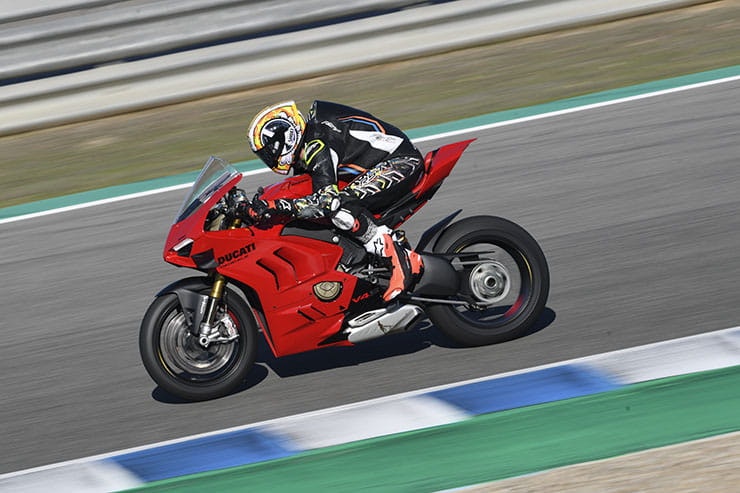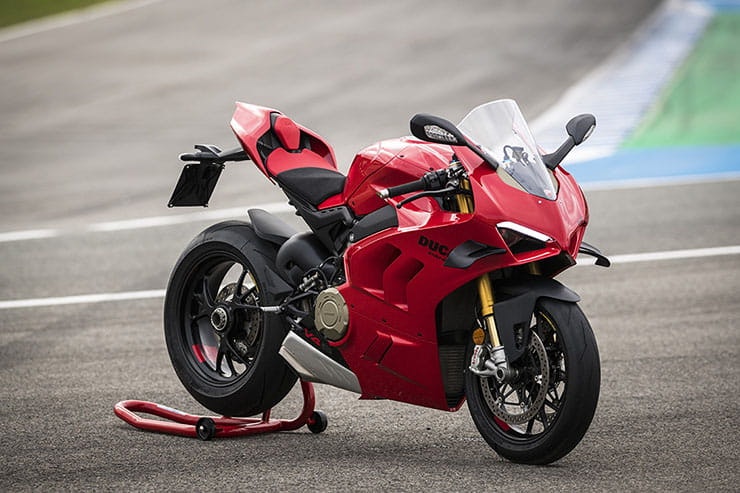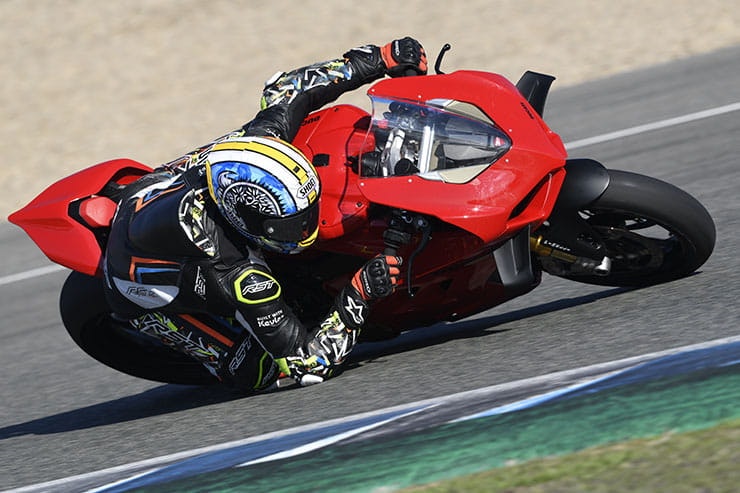Ducati Panigale V4S (2022) - Review
BikeSocial Road Tester
08.12.2021
From the outside this may not appear to be a huge leap forward for Ducati, after all it’d be a tricky job improving an already excellent bike. That said, about the new-for-2022 Panigale V4S, Ducati inform us ‘this is the most significant evolution since its birth’. The stopwatch doesn’t lie. During exclusive back-to-back testing at Vallelunga with the 2021 and 2022 models, two testers joined official Ducati test rider Michele Pirro on track. By the end of the day, one rider improved by 0.9 seconds, the second by 1.2 seconds and Pirro, by 0.5. In fact, Pirro was only 3 seconds slower than the lap time set during race one in the highly competitive Italian Superbike Championship.
Ducati has chopped lap times, especially so for less experienced riders, by improving the aerodynamic package, ergonomics, engine, chassis and rider aids. Interestingly, Ducati performed a similar trick on the 2020 model, making it easier to ride than the previous Panigale, which we tested in Bahrain pre-lockdown. This time around we went to MotoGP circuit of Jerez in Spain to see if the new Panigale could live up to the expectations and to discover if it is indeed quicker than the previous model.
Easier to ride faster
Improved electronics
Stunning looks
All the designer equipment comes with a designer price tag
Thirsty
Not ideal for nipping to Tesco
Ducati Panigale V4 (2022) Review
Faster than ever before, so the claim goes, so we sent Chad to Jerez to find out.
Ducati Panigale V4 Price
How much is the 2022 Ducati Panigale V4S? £25,995. It’s only available in red, although does have those new graphics, and it’s has edged up in price over the previous model, and if £26K is too much, the standard V4 will set you back £20,995. The S is also distinguishable via the two-tone seat.
Power and torque
Ducati hasn’t reinvented the wheel – after all it’s hard to improve on an already class-leading engine but they have managed to squeeze out a little more power from the Desmosedici Stradale V4. A new oil pump and oil circuit reduces power loss, and along with slight improvements to the exhaust, the 2022 model produces and extra 1.5hp, now 215.5hp (158.5kw) @ 13,000rpm. With more over-rev it also makes 2.5hp more than it did at 14,500rpm.
Torque-wise, the V4 delivers 123.6Nm/91.2lb-ft @ 9,500rpm, with 80% of that peak figure delivered by 6000rpm. Peak output is a fraction down compared to the previous model (124Nm/91.5 lb-ft) but if you can feel the difference, you should get a job as a Ducati test rider.
More significant is a change to the gearing. Ducati has introduced a new gearbox with a longer 1st (11.6%) and 2nd (5.6%) gear, plus a longer 6th gear (1.8%). These new ratios are more race oriented allowing the rider to use 1st gear in slower corners, for improved engine braking and acceleration. The taller 6th gear has allowed a 5kph increase in top speed and for the road and should in theory drop the rpm slightly whilst touring – should you want to.
Engine, gearbox, and exhaust
To make life easier, especially so for less experienced riders, Ducati has now introduced new electronics, including four power modes: Full, High, Medium, and Low. Full and Low are completely new for 2022, with Low reducing peak power to 150hp, whereas Full unleashes all those lovely horses, only limiting torque slightly in first gear. Each power mode has a different gear strategy too. For example, torque is limited in the first three gears in High and Medium, but not in Full. Having the ability to tailor the torque for each gear is a first for the motorcycle industry.
As standard, the V4 has Race A, Race B, Sport and Street. Our test bike was fitted with the optional ‘Track Evo’, which adds to the standard Road and Track settings. Now you have Race A Evo, Race B Evo, Wet Evo and Sport Evo, and even a mode called Jerez (other tracks are available). Track Evo changes the dash to give live lap times and splits, a clear horizontal digital rev counter, large gear position indicator and a visual ‘live’ rider aid intervention display on the right side. If, while riding, you activate any of the multi rider aids, i.e. slide control, it will change its display to colour on the dash.
The rider aids are so smooth it’s sometimes hard to feel them working, so the colour indicator on the new race dash layout is a very useful tool. Furthermore, all this tech is linked to a GPS unit, which gives live lap times and splits – it’s like a real-life video game as you chase your best lap while watching the rider aids light up in colour as they do their thing.
This new raft of rider aids dramatically changes the engine performance and usability of the new 2022 Panigale, Track Evo especially. It’s now even easier to tailor the set-up and electronic trim to exactly how you ride, the grip available and conditions. Incidentally, the Evo system has been specifically designed to work with slick tyres, or race wets.
Jerez was unseasonably cold in the morning leading me to opt for Race B Evo - maximum power, a smooth ride-by-wire throttle response, and limited torque in the first three gears, along with a plethora of rider aids set for slicks, along with the Öhlins Smart EC 2.0 semi-active suspension.
On lap one, despite ‘only’ opting for the Race B Evo the Panigale is still shockingly fast. Make that gobsmacking fast. For the first few laps I’m having to recalibrate my brain. I then realise I’ve not seen the new, much larger gear change indicator flash yet. I thought I was revving the Panigale, but it wants more, all the way to 14,500rpm. This is crazy; Jerez has never felt so tiny – and this is with limited torque in the first three gears and a ‘smooth’ throttle.
The recalibrated Stradale loves revs. It feels wrong to brutally rev a pricy, sexy desirable bike so much – but it loves it. The main straight is taken in fifth gear, then it’s back to second or first for turn one. As quick as you can read this sentence, you can back-change without the clutch – even with the revs above 12,000rpm – and there’s no complaints. With a longer first gear, it’s more usable, too, not only giving faster acceleration out of slow turns, but helping to slow the bike into corners. Revised fuelling also ensures first gear isn’t too sharp, especially with limited torque.
Upshift are equally impressive: fast and effortless. For session one I opted for the standard shift but flicked over the gear position for a race shift in session two. Tapping on the up-and-down shifter feels as good or better than many pure race set-ups I’ve used.
Once up to speed with the track and slick tyres, I opted for Race A Evo, with rider aid intervention and more aggressive power, plus Full, which only limits the torque a fraction in first gear. In Race A Evo power is a little sharper, but, not a massive step more. The rider aids, although working more in the background, are clearly shown by the new to be working, while the front wheel now lifts out of the last turn, hovering a few inches above the famous Spanish racetrack.
Full power mode allows maximum torque in all gears aside from first, which is only limited a fraction. I was a little intimidated as I left pit lane, but (minimal) lean sensitive rider aids are still at hand, and there is excellent grip from the Pirelli slicks, as well as an excellent chassis and downforce created by new wings. Full is more aggressive, especially in second gear, which in turn makes the V4 harder to ride. I found myself holding on more whilst exiting second gears corners hard on the power – it’s a tough workout but an incredible experience.
My (clearly displayed) lap times didn’t jump forward with the more aggressive modes – in perfect conditions I opted for either Race A Evo or Race B Evo. With more track time it might have been possible to reduce the rider aid intervention levels further and spend more time chipping away in Race A Evo. But that is the beauty of the new Panigale, it’s so tweakable and adjustable – so easy to set up and optimise for you and the track you ride.
Handling, suspension, and weight
Ducati has revised the V4’s ergonomics making it less physical and easier to ride, by creating a more supportive tank shape while increasing the size of its capacity by one litre. The seat (with two-tone colours on the S model) is flatter with more grip. Chassis-wise the swing-arm pivot point has been raised by 4mm to reduce squat, and the Öhlins NPX25/30 forks have new settings, softer springs, and 5mm more travel taking their stroke to 120mm.
The new ergonomics make life easier for the rider, giving more support when braking, moving on the bike and hanging off mid-corner. Softening the suspension to give more movement and feeling is deliberately for ‘normal’ track riders rather than pro superbike aces.
The changes in ergonomics are instantly noticeable even whilst leaving the Jerez pit lane. The tank is wider, the seat is flatter and gripper, and you feel more in the bike, more secure… dare I say a little old school?
When braking devilishly late, you’re no longer fighting your bodyweight from sliding up the fuel tank towards the top yoke. It’s still physical, but not as much as before. Likewise, when you’re hanging off the inside, elbow dragging on the track, the fuel tank shape gives more support, and there’s more gip from the seat.
Handling can’t just be defined by mechanical grip and handling; electronics also come into play, especially when you have over 215bhp to work with. Again, the modes come in their own as they change the Öhlins semi-active suspension. Each Evo mode has a pre-set setting, Brake Support, Front Fork, Shock Absorber, Steering Damper, Acceleration and Mid-corner. Changing from Race B Evo to Race A Evo, for example, adds more support to everything, with only the electronic steering damper remaining the same. Spring pre-load is still mechanically changed.
The difference between the modes is noticeable but not dramatic. However, the front end feeling on the 2022 bike is certainly different to the 2021 model. You have more feel from the front Pirelli slick, you get more trust, which allows you to hold the brake later and deeper. I’d imagine my corner entry speed would be higher compared to the previous model.
As always, you’re reliant on the rider aids, even with minimal settings working in the background. In Full (which allows full torque in second and third gear) the Slide and TC light illuminates from time to time, but again you can’t feel the intervention, it’s seamless, and without the lights illuminating to let you know – you’d be hard-guessed to know.
The handling is sublime, at times you have to remind yourself this is a road bike, albeit an exotic and expensive one. I’ve never felt so at home, with elbow dragging lean angles. This is a race bike out of the showroom, yet you can still ride it to Tesco’s for some milk.
Ducati has re-designed the front wings, too. They are physically smaller yet offer the same downforce as before (37kg at 300kph) and add high speed stability, which was excellent at Jerez.
Ducati Panigale V4S (2022) Comfort and economy
This was a track-only test at the Jerez MotoGP track and I only rode on slick tyres and Ducati had even removed the mirrors and numberplate. However, some of the track improvements should be beneficial on the road. The seat is roomier and more comfortable. The fuel tank has increased by 1 litre to 17 litres and, with a taller sixth gear, fuel range should have increased slightly. Ducati quote 37mpg / 7.6l/100km – the Panigale has always been a thirsty bike. A full tank of fuel will only last a few sessions on track, and the fuel light will illuminate in less than 100 miles on the road if ridden hard.
Brakes
The brakes remain the same: top quality Brembo Monobloc Stylema R 4-piston callipers with Bosch Cornering ABS EVO. Like the engine, Ducati didn’t need to improve this area of the motorcycle as the cornering ABS is class leading. In Race modes, the rear brake doesn’t have ABS, but was hardly used when pushing for lap times.
The change to the front end now allows you to make even more use of the excellent stoppers. The revised ergonomics also make it less physical for the rider, allowing you to brake later with the same effort. The Brembo Stylema brakes with changeable engine brake strategies are hugely impressive. The aero-package also add to stability when you make the initial grab of the lever as there’s more weight on the front. Watching MotoGP riders, Johann Zarco and Jorge Martin braking for turn one at Jerez was mesmerising. Each lap I thought they had left it too late, but they still made it.
Rider aids, extra equipment, and accessories
This list of rider aids is impressive and refined further for 2022. At your disposal are ABS Cornering EVO, Ducati Traction Control (DTC) EVO 3, Ducati Slide Control (DSC), Ducati Wheelie Control (DWC) EVO, Ducati Power Launch (DPL), Ducati Quick Shift up/down (DQS) EVO 2, Engine Brake Control (EBC) EVO and Ducati Electronic Suspension (DES) EVO – this all standard.
Modes as standard are Race A, Race B, Sport and Street. These are designed for standard tyres, for the track and the road. Each mode changes the rider aids and the electronic suspension to match.
As mentioned, our test bike was fitted with the optional ‘Track Evo’ which works with the GPS and adds to the existing Road and Track settings. This is a plug-in system, which is fitted by a Ducati dealer.
Ducati offer a new full titanium exhaust made in partnership with Akrapovic, which falls within the typical 105db noise limit for trackdays and can further be reduced to 102db. With stunning high silencers, it increases power by 12.5hp, bringing maximum power to 228hp, with torque increased to 131Nm. Weight is also reduced by 5kg. Price: £6,156.
Rivals
As the battle for superbike supremacy emanates from the track weapons as seen in World and British Superbike Championships, including the four Japanese entrants and BMW as the main contenders. Aprilia’s RSV4 1100 is a fine competitor too but given its capacity, renders it illegal for short circuit racing so we’ve left it out of the following high-level comparison chart:
Above: MotoGP riders, Johann Zarco and Jorge Martin, show us how it’s done
Ducati Panigale V4S (2022) Verdict
To improve on an already excellent bike was an incredibly tough task and I found very few faults with the old V4S (on the track). But Ducati has not only made the new bike quicker at the racetrack, it has also made is more accessible and easier to ride – more so for those of us who haven’t raced at the world level. The improved ergonomics, braking, suspension, electronics, and aerodynamics all work together to make the Panigale more rideable than ever before. Ducati hasn’t messed with a proven recipe, the engine and looks are similar, the brakes are mechanically identical – what wasn’t broke has not been fixed.
Ducati’s updates mean you can push harder and for longer. Even after a full day at Jerez, I wasn’t exhausted. Furthermore, this ease of use should translate to the road but we will have to wait and see about that.
Arguably the world’s most desirable production bike is now even better, a stunning poster bike for 2022, that is race bike-like on track, but you don’t have to be a professional to enjoy.
Ducati Panigale V4S (2022) Technical Specification
Photos: Ducati - ALEX PHOTO (Cavadini-Barbanti-Puig)
Video/editing: Write Stuff Media
What is MCIA Secured?
MCIA Secured gives bike buyers the chance to see just how much work a manufacturer has put into making their new investment as resistant to theft as possible.
As we all know, the more security you use, the less chance there is of your bike being stolen. In fact, based on research by Bennetts, using a disc lock makes your machine three times less likely to be stolen, while heavy duty kit can make it less likely to be stolen than a car. For reviews of the best security products, click here.
MCIA Secured gives motorcycles a rating out of five stars, based on the following being fitted to a new bike as standard:
A steering lock that meets the UNECE 62 standard
An ignition immobiliser system
A vehicle marking system
An alarm system
A vehicle tracking system with subscription
The higher the star rating, the better the security, so always ask your dealer what rating your bike has, and compare it to other machines on your shortlist.


